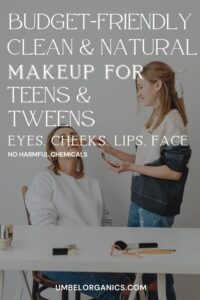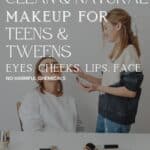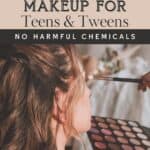Non-Toxic, Clean Beauty On A Budget
A roundup of non-toxic, clean, natural and organic makeup for teens, tweens and anyone on a budget. Whether you’re looking for affordable makeup for the eyes, face + cheeks and lips, I’ve got a list of budget-friendly clean, natural, organic, non-toxic makeup that’s $30 and under.
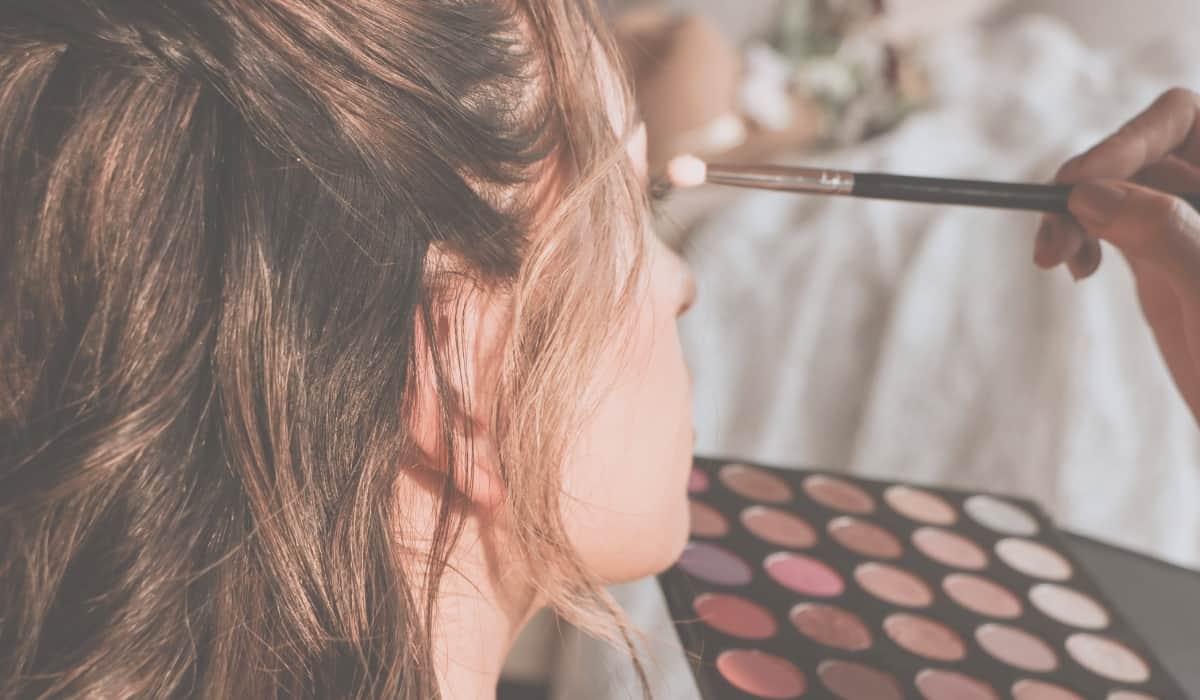
Disclosure: This post contains affiliate links, which means if you make a purchase through these links, we may receive a small commission at no extra cost to you.
I’m always on the lookout for budget-friendly clean makeup for my 2 teenage girls. According to Dr. Kim Harley, Faculty Director of Wallace Center for Maternal, Child and Adolescent Health, teens may be at higher risk of exposure to harmful chemicals in personal care products due to rapid reproductive development.
Research indicates that it really does matter what types of products teens are using in their beauty routines. In a 2016 study, 100 Latina teenagers had their urine tested for endocrine-disrupting chemicals before and after using products free from phthalates, parabens, triclosan and oxybenzone for 3 days. In that short amount of time, there were significant drops in the amounts of most of the endocrine-disrupting chemicals after using the non-toxic products.
When it comes to my teenagers and myself, I make a conscious decision to purchase makeup products that don’t contain any endocrine-disrupting chemicals. After reviewing ingredients from specific products, I found that there aren’t really any specific brands with 100% clean products (for example, W3LL People Lip Gloss contains questionable dyes and a preservative that I wouldn’t want on my lips). I’ve included a list of ingredients to avoid below my recommendations for product that I would use or give to my teenagers to use.
I put together a list of non-toxic makeup products that won’t break the bank, since clean, organic and natural makeup can be on the pricey side. With categories ranging from eyes to face + Cheeks to lips + nails, all of the makeup I’ve listed is $30 and under.
Beyond clean, natural and non-toxic makeup for tweens, teenagers, and young adults, there are options for budget-friendly clean face lotion and budget-friendly clean face wash. Below is a list of non-toxic, clean and natural makeup that’s a healthy option for tweens, teens, young adults and anyone looking for skincare and makeup that doesn’t contain harmful ingredients like endocrine disruptors and PFAS chemicals.
*Cost was calculated at the time this article was published, and is subject to change.
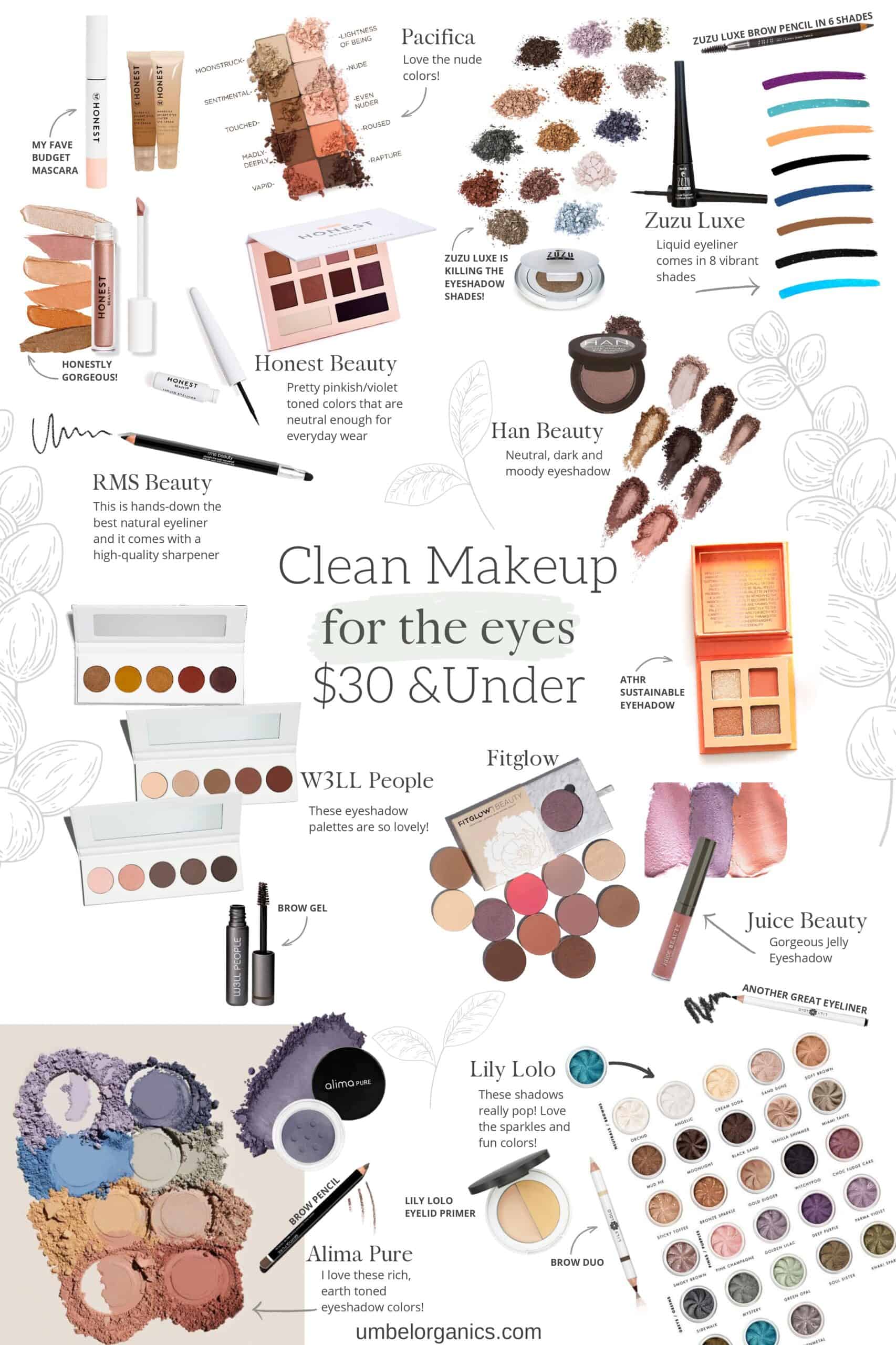
for the eyes
Mascara
- Honest Extreme Length Mascara + Lash Primer $17 (Black)
- Lily Lolo Natural Vegan Mascara $20 (Black)
- Ilia Limitless Lash Mascara $28 (Black)
Eyeliner
- RMS Beauty Straight Line Kohl Eyeliner $22 (Black, Bronze, Plum)
- Antonym Eye Pencil $21 (Black Noir, Brown, Steel)
- Lily Lolo Natural Eye Pencil $16 (New Black, Brown)
- W3LL People Eyeliner $17 (2 shades)
- W3LL People Liquid Eyeliner $17 (Black)
- Zuzu Luxe Liquid Eyeliner $17 (8 shades)
- Hynt Forte High Definition Eyeliner $22 (Black)
Eyeshadow
- Lily Lolo Pressed Eye Shadow $14 (14 shades)
- Honest Eyeshadow Palette $23 (10 shades in the palette)
- Honest Eye Catcher Lid Tint $18 (5 shades)
- Honest Tinted Eye Cream $23 (2 shades)
- Pacifica Pink Nudes Eyeshadow Palette $18 (10 shades in the palette)
- Alima Pure Limited Edition Loose Mineral Eyeshadow $18 (9 shades)
- Juice Beauty Jelly Eyeshadow $24 (3 shades)
- Hynt Beauty Pressed Eyeshadow $22 (3 shades)
- Hynt Beauty Loose Powder Eyeshadow $18 (10 shades)
Brow Gel/Pencil
- W3LL People Expressionist Brow Gel $16 (Blond, Brown, Dark Brown)
- Zuzu Luxe Eyebrow Pencil $16 (Fig, Flint, Mink, Flax, Jet, Russet)
- Lily Lolo Brow Duo Pencil $16 (Light, Medium)
- Alima Pure Natural Definition Brow Pencil $22 (Blond, Brunette, Raven)
- Hynt Beauty Eyebrow Cream $28 (Pearl, Taupe, Blonde, Black, Espresso)
Eyelid Primer
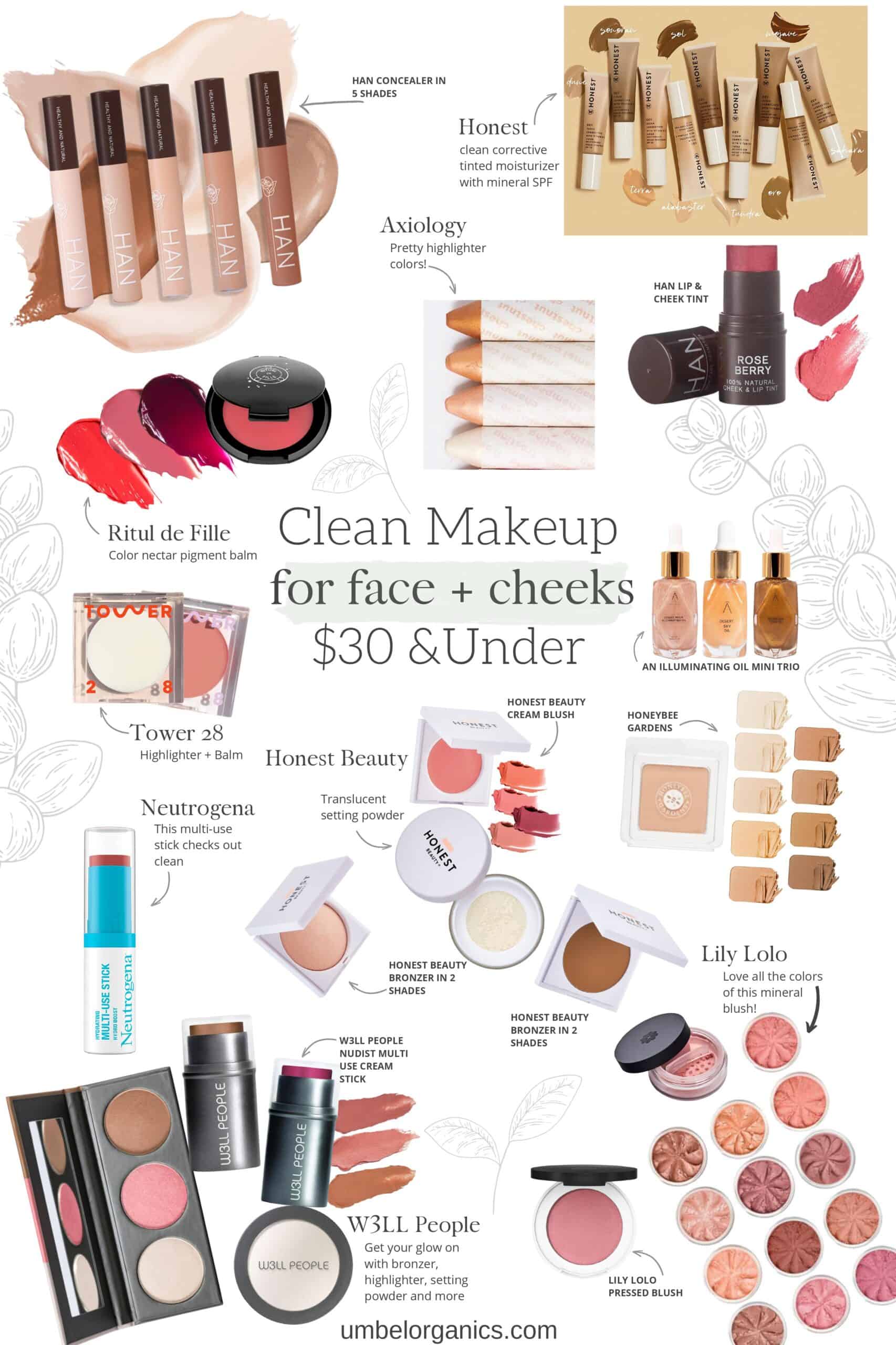
face + cheeks
Concealer
- Honest Fresh Flex Concealer $20 (16 shades)
- Honest Everything Primer & Glow $20
- W3LL People Bio Correct Concealer $22 (20 shades)
- Han Concealer $20 (7 shades)
- Lily Lolo Cream Concealer $21 (5 shades)
Highlighter
- Honest Beauty Balm $13
- Axiology Lip-To-Lid Balmie Highlighter $15
- Tower 28 Superdew Highlighter Balm $18
- W3LL People Supernatural Highlighter Stick $22 (2 shades)
- Lily Lolo Illuminator $26 (3 shades)
Blush
- Neutrogena Multi-Use Stick $13
- Lily Lolo Pressed Blush $20 (7 shades)
- Lily Lolo Mineral Blush $18 (9 shades)
- Tower 28 BeachPlease Luminous Tinted Balm $20 (7 shades)
- W3LL People Supernatural Stick Multi-Use Blush $22 (6 shades)
- Han Multistick $18 (8 shades)
- Hynt Beauty Loose Powder Blush $28 (4 shades)
- Axiology Lip-To-Lid Balmie Stick $15 (10 shades)
Setting Powder
- W3LL People Superpowder Brightening Powder $20 (Moonstone)
Bronzer
- Pacifica Sundreams Matte Cream Bronzer $11 (5 shades)
- W3LL People Supernatural Stick Bronzer $16 (4 shades)
- Tower 28 Bronzino Illuminating Bronzer $20 (2 shades)
Foundation
- Honeybee Gardens Pressed Mineral Powder Foundation $12 (9 shades)
- Honest CCC Clean Corrective Tinted Moisturizer SPF 30 $20 (9 shades)
- Honest Beauty Everything Cream Foundation $19 (3 shades)
- Tower 28 Sculptino Soft Cream Contour $20 (4 shades)
- W3LL People Bio Stick Foundation $27 (14 shades)
- W3LL People Bio Powder Foundation $27 (12 shades)
- Lily Lolo Mineral Foundation $22 (18 shades)
- Lily Lolo Cream Foundation $26 (7 shades)
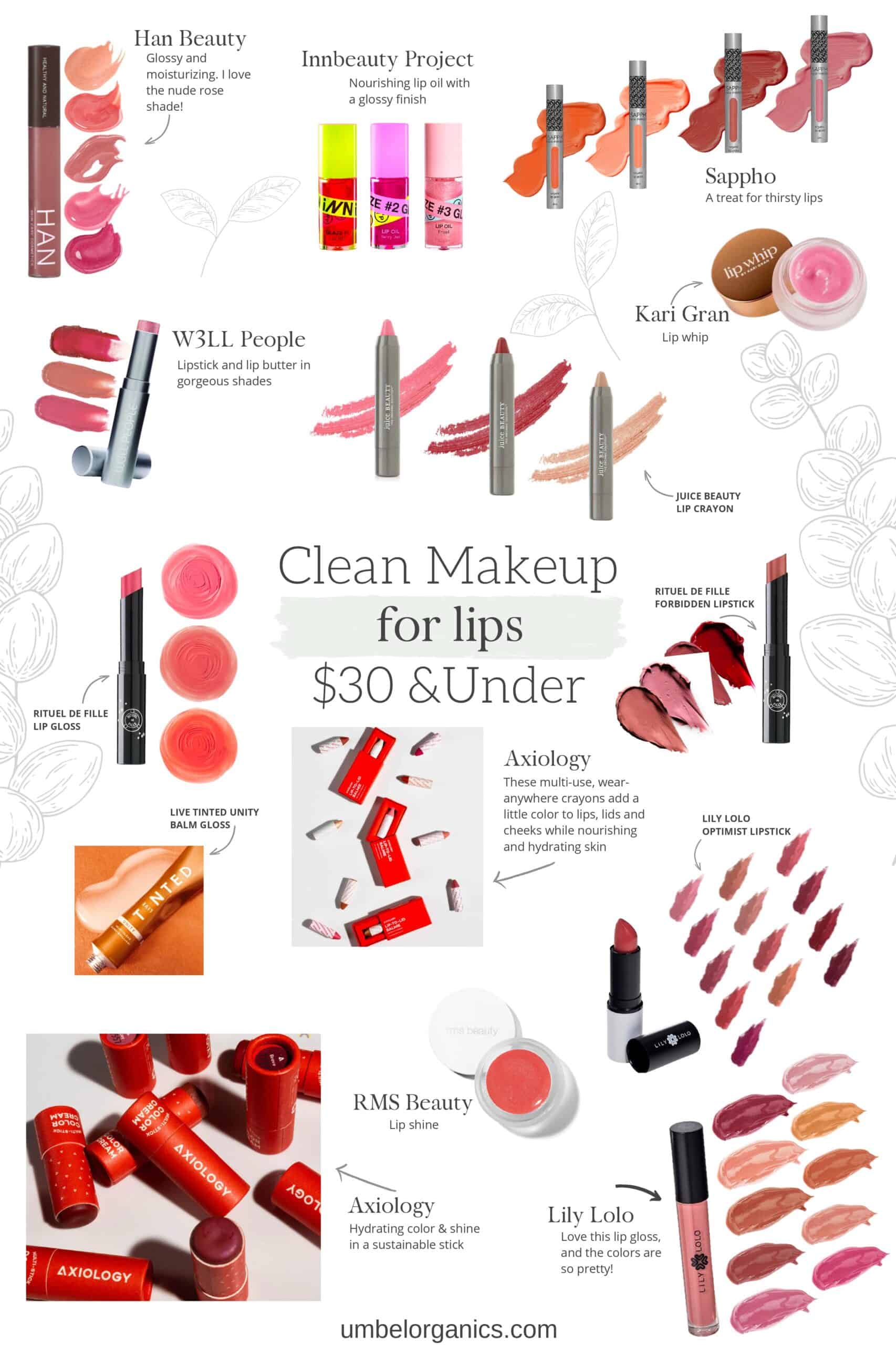
lips
Lip Gloss
- Innbeauty Project Lip Oil $15 (4 shades)
- Lily Lolo Lip Gloss $16 (9 shades)
- Han Lip Gloss $16 (5 shades)
- Sappho Lip Gloss $25 (4 shades)
Lip Balms, Butters & Tints
- Pacifica Color Quench Lip Tint $5 (6 shades)
- Honest Beauty Balm $13
- W3LL People Tinted Lip Butter SPF 15 $15 (4 shades)
- Axiology Lip-To-Lid Balmie Stick $15 (10 shades)
- Kari Gran Tinted Lip Whip $20 (Cinnamon, Peppermint)
- Axiology Multi-Sticks $24 (7 shades)
- RMS Beauty LipShine $25
- Rituel De Fille Enchanted Lip Sheer $25 (3 shades)
Lipstick
- W3LL People Optimist Lipstick $16 (8 shades)
- Lily Lolo Natural Lipstick $19 (7 shades)
- Rituel De Fille Forbidden Lipstick $25 (4 shades)
Lip Liner
- Lily Lolo Natural Lip Pencil $16 (3 shades)
Avoid These Ingredients In Makeup
- Aluminum Powder- Aluminum powder is a metallic compound used as a cosmetic colorant in eye makeup. It’s a byproduct of aluminum manufacturing and is considered a neurotoxin. It is listed on makeup labels as aluminum, LB Pigment 5 or pigment metal.
- BAK- Benzalkonium chloride (BAK) is a preservative found in eyeliner, mascara and makeup remover. A 2009 study found BAK to be toxic to the epithelial cells of the eyes. BAK may be listed as benzalkonium chloride, quaternium-15 or guar hydroxypropyltrimonium chloride.
- BHA and BHT- Butylated hydroxytoluene (BHA) and butylated hydroxyanisole (BHT) are preservatives derived from petroleum and found in some mascara formulas. BHA is an endocrine disruptor and a possible carcinogen. BHT is a respiratory irritant and is considered toxic or harmful to human organ systems.
- Carbon black- Carbon black delivers color to traditional mascara and other eye makeup. It’s been linked to cancer and organ system toxicity. Look for labels with carbon black, D & C Black No. 2, pigment black 6 or 7, acetylene black, channel black, furnace black, lamp black and thermal black.
- Coal Tar Dyes- Coal tar is recognized as a human carcinogen and may be contaminated with low levels of heavy metals. These dyes are used as a colorant in eye makeup. You may find them listed as CI followed by a five digit number. (includes FD&C Blue No. 1 or Blue 1, Green 3, Yellow 5, Yellow 6, Red 33, etc.) They may also be labeled as Aminphenol, Diaminodenzene or Phenylenediamine.
- Ethanolamine compounds (labelled as DEA, TEA and MEA)- Ethanolamines may be contaminated with nitrosamines, which are cancer-causing chemicals.
- Formaldehyde- Diazolidinyl urea, Imidazolidinyl Urea, DMDM hydantoin, methenamine and quarternium-15 are formaldehyde-releasing preservatives found in cosmetics. Formaldehyde is a known carcinogen as well as a skin irritant.
- Lake Dyes– In general, lake dyes are petroleum derived colorants that may be contaminated with polycyclic aromatic hydrocarbons (PAHs) Specifically, the dyes Red 40, Yellow 5, and Yellow 6 can be contaminated with benzidine or other carcinogens.
- Parabens- Parabens are a type of preservative used to prevent the growth of bacteria and prolong the shelf life of lip balm, deodorant, lotion, and other beauty products. The most commonly used are methylparaben, ethylparaben, propylparaben, isobutylparaben and butylparaben. Parabens disrupt hormone function and are linked to increased risk of breast cancer and reproductive toxicity. A 2004 study found high concentrations of parabens in breast tumor samples. The European Union banned the use parabens in cosmetics in 2012.
- Phenoxyethanol– Phenoxyethanol is a preservative found in skincare and cosmetics that is an ethoxylated ingredient. Ethoxylates can be contaminated with 1,4-dioxane and ethylene oxide, both of which are associated with reproductive, developmental and endocrine effects, and these compounds can be carcinogenic.
- Synthetic fragrance- Beauty products can list fragrance as one ingredient and don’t have to disclose the fact that these formulations may contain hundreds of ingredients. Synthetic Fragrance may contain carcinogens, endocrine disruptors, allergens, respiratory irritants and neurotoxic chemicals (14). Synthetic musks like galaxolide and tonalide, are linked to hormone disruption. Fragrance formulations also contain phthalates, which are hormone disruptors.
More Clean Beauty Inspiration
- Budget-Friendly Clean Face Lotion
- Budget-Friendly Clean Face Wash
- Clean, Natural, Non-Toxic Shampoo
- Make The Switch To Natural Deodorant
- Organic & Natural Lip Balm For Dry Lips
- The Best Natural Mascara
- The Best Clean & Natural Lotion For Dry Skin
- Make The Switch To Natural Dry Shampoo
- The Best Natural & Clean Eyeliners
